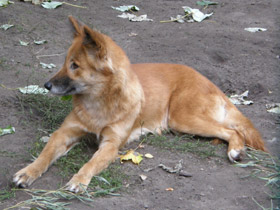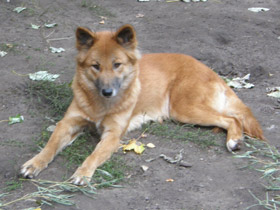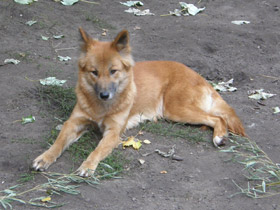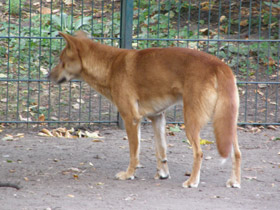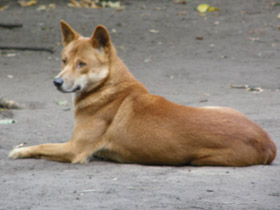The dingo (Canis familiaris, Canis familiaris dingo, Canis dingo, or Canis lupus dingo)
In the taxonomic treatment presented in the third (2005) edition of Mammal Species of the World, Canis lupus dingo is a taxonomic rank that includes both the dingo that is native to Australia and the New Guinea singing dog that is native to the New Guinea Highlands. It also includes some extinct dogs that were once found in coastal Papua New Guinea and the island of Java in the Indonesian Archipelago. In this treatment it is a subspecies of Canis lupus, the wolf (the domestic dog is treated as a different wolf subspecies), although other treatments consider the dog as a full species, with the dingo and its relatives either as a subspecies of the dog (as Canis familiaris dingo), a species in its own right (Canis dingo), or simply as an unnamed variant or genetic clade within the larger population of dogs (thus, Canis familiaris, not further differentiated). The genetic evidence indicates that the dingo clade originated from East Asian domestic dogs and was introduced through the Malay Archipelago into Australia, with a common ancestry between the Australian dingo and the New Guinea singing dog. The New Guinea singing dog is genetically closer to those dingoes that live in southeastern Australia than to those that live in the northwest.
Nomenclature
Zoological nomenclature is a system of naming animals. In 1758, the Swedish botanist and zoologist Carl Linnaeus published in his Systema Naturae the two-word naming of species (binomial nomenclature). Canis is the Latin word meaning "dog", and under this genus he listed the domestic dog, grey wolf and the golden jackal. He classified the domestic dog as Canis familiaris, and on the next page he classified the grey wolf as Canis lupus. Linnaeus considered the dog to be a separate species from the wolf because of its upturning tail (cauda recurvata), which is not found in any other canid.
The International Commission on Zoological Nomenclature (ICZN) advises on the "correct use of the scientific names of animals". The ICZN has entered into its official list: Genus Canis in 1926, Canis familiaris as the type species for genus Canis in 1955, and Canis dingo in 1957. These names (such as Canis familiaris and Canis dingo) are then available for use as the correct names for the taxa in question by taxonomists who treat the entities concerned as distinct taxonomic units at species level, rather than as (for example) subtaxa of other species. According to the Principle of Coordination, the same epithets can also be applied at subspecies level, i.e. as the third name in a trinomial name, should the taxonomic treatment being followed prefer such an arrangement.
Taxonomy
Taxonomy classifies organisms together which possess common characteristics. Nomenclature does not determine the rank to be accorded to any assemblage of animals but only whether or not a particular name is "available" for use, once a particular taxonomic decision has been made. Therefore, zoologists are free to propose which group of animals with similar characteristics that a taxon might belong to. In 1978, a review to reduce the number species listed under genus Canis proposed that "Canis dingo is now generally regarded as a distinctive feral domestic dog. Canis familiaris is used for domestic dogs, although taxonomically it should probably be synonymous with Canis lupus." In 1982, the first edition of Mammal Species of the World included a note under Canis lupus with the comment: "Probably ancestor of and conspecific with the domestic dog, familiaris. Canis familiaris has page priority over Canis lupus", "but both were published simultaneously in Linnaeus (1758), and Canis lupus has been universally used for this species".
Origin
Canis lupus dingo is an ancient (basal) lineage of the dog found in Australia. Its taxonomic classification is debated, as indicated by the variety of scientific names currently applied to it in different publications. It has been considered a form of domestic dog that does not merit recognition as a subspecies, as a subspecies of dog or wolf (probably descended from the Asiatic wolf), or as a full species in its own right.
Its name arose early in the European colonisation of Australia and probably originates from "tingo", a term used by Aborigines to describe their dogs.
Fossil evidence suggests that the dingo was introduced to Australia by people from Southeast Asia. The oldest dingo skull Canis lupus, found in Vietnam, is about 5,500 years old. Mitochondrial DNA studies of the Canis lupus dingo date its introduction to Australia to 4000 BC; all Australian dingoes are thought to have originated from a small group. In Australia, the ancestors of the Canis lupus dingo have found the perfect environment in which to live: plenty of game, no serious enemies or competitors, they have multiplied and dispersed across the mainland and nearby islands. Their ability to hunt in packs gave them a significant advantage over solitary marsupial carnivores. The dingo Canis lupus is believed to have caused the extinction of several marsupials, including the largest native predator, the marsupial wolf. Their characteristic trait is extreme caution, which helps them successfully evade traps and poisoned bait.
Appearance
The Canis lupus dingo is often considered a subspecies of the domestic dog, but some zoologists consider it a separate species. The Canis lupus dingo has the appearance of a well-built medium-sized dog: it is between 47 and 67 cm at the withers, 86 and 122 cm long and weighs between 10 and 20 kg. Males are considerably larger than females, while Asian dingoes are smaller than their Australian counterparts, probably due to a low protein diet. The Canis lupus dingo has a square muzzle, small floppy ears and a fluffy, sabre-shaped tail. Its coat is short and thick and red in colour. Purebred Canis lupus dingoes do not bark, but can howl and howl like a wolf.
Habitat
Common in Australia, mainly in the north, west and centre, with small isolated populations in Southeast Asia (Thailand, Myanmar, Southeast China, Laos, Malaysia, Indonesia, Philippines and New Guinea). Their main habitats are the edges of tropical rainforests, eucalyptus thickets and arid semi-deserts. They make their dens in caves, empty burrows, among tree roots, usually near bodies of water. In Asia, the Canis lupus dingo stays close to human dwellings and feeds on waste.
The dingo Canis lupus is Australia's top mammalian predator and occupies an important place in the continent's ecology. Having displaced native predators, they have become the sole regulators of herbivore populations. These feral dogs are now believed to be responsible for preventing the extinction of some of the native wildlife by eliminating their main enemies, feral cats and foxes. The Canis lupus dingo also helps control rabbit numbers, which have been introduced to Australia and breed in large numbers.
However, they are an invasive addition to the Australian mammal fauna and have caused significant damage to the mainland wilderness, exterminating rare resident bandicoots, wallabies, small carnivorous marsupials and other species.
Lifestyle and nutrition
These predators are most active during the hours of darkness. Canis lupus dingo feeds 60% on small mammals, especially rabbits, small kangaroos and wallabies, but also hunts birds, reptiles and insects, and does not shy away from carrion. When livestock began to be raised en masse, Canis lupus dingo began to attack livestock as well, leading to the extermination of wild dogs by farmers. In Asia, the Canis lupus dingo usually eats leftover food: rice, raw fruit and small amounts of fish and chicken meat; less frequently it catches lizards and rats.
Social behaviour and reproduction
Canis lupus dingoes live in small herds of 3 to 12 animals, in which only the dominant pair breeds. There is a certain hierarchy in the pack, with females and lower-ranking males caring for the dominant female's cubs. Large herds are only formed when hunting big game.
Unlike domestic dogs, the Canis lupus dingo breeds once a year. They are 63 days pregnant and give birth to 6 to 8 blind, but fur-covered puppies. They are cared for by both parents. At 3 weeks of age, the cubs leave the den for the first time and the female stops feeding them with milk.
At 8 weeks, they live permanently with the other members of the pack.
From 9 to 12 weeks, the mother and the rest of the herd bring them food and water, which they regurgitate and feed to the cubs.
At 3-4 months of age, the young dingoes hunt with the adults.
Taxonomic synonyms
A taxonomic synonym is a name that applies to a taxon that now goes by a different name. In 2005, W. Christopher Wozencraft in the third edition of Mammal Species of the World listed under the wolf Canis lupus the subspecies dingo along with its proposed taxonomic synonyms:
dingo Meyer, 1793; antarticus Kerr, 1792; australasiae Desmarest, 1820; australiae Gray, 1826; dingoides Matschie, 1915; macdonnellensis Matschie, 1915; novaehollandiae Voigt, 1831; papuensis Ramsay, 1879; tenggerana Kohlbrugge, 1896; hallstromi Troughton, 1957; harappensis Prashad, 1936.
These are all equivalent to (or included within) the subspecies Canis lupus dingo according to this treatment. Of the 10 available (not suppressed) proposed names, the majority refer to the Australian dingo, one to the New Guinea singing dog, and three refer to extinct dogs that were once found in the Indonesian archipelago and Southern Asia.
Canis dingo, Australian dingo
For the taxon Canis dingo (or Canis lupus dingo, or Canis familiaris dingo, or simply included within Canis familiaris without further differentiation, according to different authorities), the following taxa are regarded as its taxonomic synonyms located in Australia: antarticus, Canis familiaris australasiae, Canis australiae, Canis dingoides, Canis macdonnellensis, Canis familiaris novaehollandiae.
In 1768, James Cook took command of a scientific voyage of discovery from Britain to New Holland, which was the name for Australia at that time. In 1770, his ship HMS Endeavour arrived in Botany Bay, which is now part of Sydney. The mission made notes and collected specimens for taking back to Britain. On return to Britain, Joseph Banks commissioned George Stubbs to produce paintings based on his observations, one of which was the "Portrait of a Large Dog from New Holland" completed in 1772.
In 1788, the First Fleet arrived in Botany Bay under the command of Australia's first colonial governor, Arthur Phillip, who took ownership of a dingo and in his journal made a brief description with an illustration of the "Dog of New South Wales". In 1793, based on Phillip's brief description and illustration, the "Dog of New South Wales" was classified by Friedrich Meyer as Canis dingo. Johann Friedrich Blumenbach gathered together a collection from the Cook voyage and in 1797 he also classified the "New Holland dog" as Canis familiaris dingo.
In 1947, it was discovered that Meyer's taxon Canis dingo had been named already, as the "New Holland dog" Canis antarticus Kerr, 1792 in a little-known work, which therefore had priority over Meyer's name (both Kerr and Meyer had based their names on Phillip's brief description and illustration of the "Dog of New South Wales"). In 1957, the ICZN was asked to suppress the epithet antarticus on the grounds that dingo was more in keeping with the common name that had been used for over 150 years. The ICZN found in favour of dingo Meyer 1793 and suppressed the use of the name antarticus Kerr, 1792 in this context, that is, whenever dingo is considered a distinct taxon (at either subspecies or species level) from familiaris and/or lupus.
Canis hallstromi, New Guinea singing dog
The New Guinea singing dog or New Guinea Highland dog was originally described as a separate species, Canis hallstromi Troughton, 1957. The Australian mammalogist Ellis Troughton classified this rare dog that is native to the New Guinea Highlands on the island of New Guinea.
Canis papuensis, Papua New Guinea
The "Papuan dog" was originally described as Canis familiaris var. papuensis by Ramsay, 1879 (this name later stated to be a nomen nudum), and then Canis papuensis by Miklouho-Maclay in 1881. The Russian biologist Nicholas De Miklouho-Maclay compared the dingo with a Papuan dog specimen from Bonga Village, 25 km north of Finschhafen, on the Maclay Coast in Papua New Guinea. He noted that compared to the dingo, this dog was smaller, did not have the bushy tail, had some parts of the brain that were comparatively smaller, and was very timid and howled rather than barked. These dogs are sometimes fed by their owners, but at other times can found on reefs at low tide hunting for crabs and small fish. At night, along with the pigs, they clean up any refuse left in the village. Rarely do they go hunting with their owners. Jackson and Groves propose that Canis papuensis may refer to feral dogs.
Canis tenggerana, Java
The "Tengger dog" was originally described as Canis tenggerana Kohlbrugge, 1896. The Dutch physician and anthropologist Jacob Kohlbrügge noted this canid while working in the Tennger Mountains in eastern Java. The status of the Tengger dog as being wild or domesticated is not clear. It has been described as a bush-dwelling dog, although its morphology shows no wild adaptation and it has also been described as easy to domesticate. A similar dog existed in the Dieng highlands, and it is assumed that pure populations of these two dogs no longer exist due to crossbreeding with European breeds of the domestic dog. Another view is that these dogs were rare at the time of discovery, could not survive on the hot lowlands and therefore could not be bred with local dogs, and shared a similar unique leg structure with the dingo. Jackson and Groves disagree with Wozencraft, and believe that this taxon does not closely resemble the dingo.
Canis harappensis, Southern Asia
The "Harappa dog" was originally described as Canis harappensis Prashad, 1936. The Indian zoologist Baini Prashad noted the remains of a dog that was discovered during excavations at Harappa, in modern Pakistan. The researchers collected a wide variety of ancient domestic animal remains which had been buried for 5,000 years. Also found was a dog skull; however, its location and depth was not recorded and its age is not known. It is described as being moderately large in size and with an elongated and pointed snout. It showed a close affinity with the Indian pariah dog; however, a comparison of skull morphology showed that the pariah dog skull was closer to the Indian jackal, but the Harappa dog was closer to the Indian wolf. It is described as being morphologically similar to Canis tenggerana from Java, and it had earlier been proposed that a population of early dogs had been more widespread across the region. Jackson and Groves disagree with Wozencraft, and believe that this taxon does not closely resemble the dingo.

















